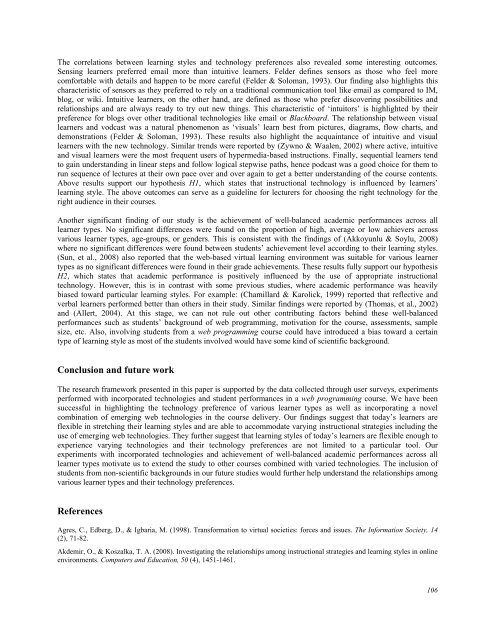October 2009 Volume 12 Number 4 - Educational Technology ...
October 2009 Volume 12 Number 4 - Educational Technology ...
October 2009 Volume 12 Number 4 - Educational Technology ...
You also want an ePaper? Increase the reach of your titles
YUMPU automatically turns print PDFs into web optimized ePapers that Google loves.
The correlations between learning styles and technology preferences also revealed some interesting outcomes.<br />
Sensing learners preferred email more than intuitive learners. Felder defines sensors as those who feel more<br />
comfortable with details and happen to be more careful (Felder & Soloman, 1993). Our finding also highlights this<br />
characteristic of sensors as they preferred to rely on a traditional communication tool like email as compared to IM,<br />
blog, or wiki. Intuitive learners, on the other hand, are defined as those who prefer discovering possibilities and<br />
relationships and are always ready to try out new things. This characteristic of ‘intuitors’ is highlighted by their<br />
preference for blogs over other traditional technologies like email or Blackboard. The relationship between visual<br />
learners and vodcast was a natural phenomenon as ‘visuals’ learn best from pictures, diagrams, flow charts, and<br />
demonstrations (Felder & Soloman, 1993). These results also highlight the acquaintance of intuitive and visual<br />
learners with the new technology. Similar trends were reported by (Zywno & Waalen, 2002) where active, intuitive<br />
and visual learners were the most frequent users of hypermedia-based instructions. Finally, sequential learners tend<br />
to gain understanding in linear steps and follow logical stepwise paths, hence podcast was a good choice for them to<br />
run sequence of lectures at their own pace over and over again to get a better understanding of the course contents.<br />
Above results support our hypothesis H1, which states that instructional technology is influenced by learners’<br />
learning style. The above outcomes can serve as a guideline for lecturers for choosing the right technology for the<br />
right audience in their courses.<br />
Another significant finding of our study is the achievement of well-balanced academic performances across all<br />
learner types. No significant differences were found on the proportion of high, average or low achievers across<br />
various learner types, age-groups, or genders. This is consistent with the findings of (Akkoyunlu & Soylu, 2008)<br />
where no significant differences were found between students’ achievement level according to their learning styles.<br />
(Sun, et al., 2008) also reported that the web-based virtual learning environment was suitable for various learner<br />
types as no significant differences were found in their grade achievements. These results fully support our hypothesis<br />
H2, which states that academic performance is positively influenced by the use of appropriate instructional<br />
technology. However, this is in contrast with some previous studies, where academic performance was heavily<br />
biased toward particular learning styles. For example: (Chamillard & Karolick, 1999) reported that reflective and<br />
verbal learners performed better than others in their study. Similar findings were reported by (Thomas, et al., 2002)<br />
and (Allert, 2004). At this stage, we can not rule out other contributing factors behind these well-balanced<br />
performances such as students’ background of web programming, motivation for the course, assessments, sample<br />
size, etc. Also, involving students from a web programming course could have introduced a bias toward a certain<br />
type of learning style as most of the students involved would have some kind of scientific background.<br />
Conclusion and future work<br />
The research framework presented in this paper is supported by the data collected through user surveys, experiments<br />
performed with incorporated technologies and student performances in a web programming course. We have been<br />
successful in highlighting the technology preference of various learner types as well as incorporating a novel<br />
combination of emerging web technologies in the course delivery. Our findings suggest that today’s learners are<br />
flexible in stretching their learning styles and are able to accommodate varying instructional strategies including the<br />
use of emerging web technologies. They further suggest that learning styles of today’s learners are flexible enough to<br />
experience varying technologies and their technology preferences are not limited to a particular tool. Our<br />
experiments with incorporated technologies and achievement of well-balanced academic performances across all<br />
learner types motivate us to extend the study to other courses combined with varied technologies. The inclusion of<br />
students from non-scientific backgrounds in our future studies would further help understand the relationships among<br />
various learner types and their technology preferences.<br />
References<br />
Agres, C., Edberg, D., & Igbaria, M. (1998). Transformation to virtual societies: forces and issues. The Information Society, 14<br />
(2), 71-82.<br />
Akdemir, O., & Koszalka, T. A. (2008). Investigating the relationships among instructional strategies and learning styles in online<br />
environments. Computers and Education, 50 (4), 1451-1461.<br />
106

















